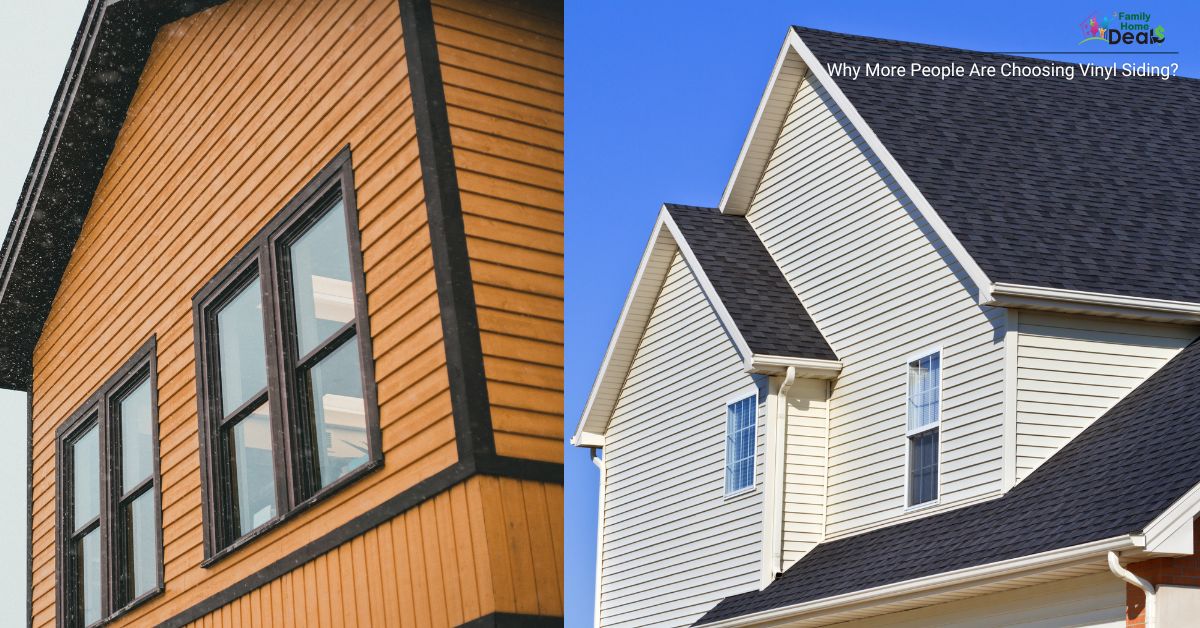
The American Dream has always included the perfect house—a cozy space with curb appeal, style, and charm. While the definition of that dream has evolved, one thing remains the same: homeowners want a beautiful, low-maintenance exterior that doesn’t break the bank. Enter vinyl siding, the unsung hero of modern home design. Once viewed as a budget-friendly fix for aging homes, vinyl siding has undergone a stylish evolution and now dominates neighborhoods from coast to coast.
Whether you’re building a new home or revamping an old one, choosing the right siding material is a major decision. With so many options—wood, fiber cement, metal, and composites—it’s easy to get overwhelmed. But more Americans than ever are gravitating toward vinyl siding in 2025. So, what’s driving this trend? Let’s dive into the benefits, considerations, and alternatives to help you make an informed choice for your home.
The Vinyl Revolution: What’s Fueling Its Popularity?
1. Affordability That Doesn’t Sacrifice Style
Let’s face it—cost is always a factor in home improvement. One of the biggest reasons vinyl siding remains a top choice in 2025 is that it offers the look of wood without the price tag. Compared to cedar shingles or fiber cement, vinyl is significantly more affordable. According to recent data from Remodeling Magazine’s 2025 Cost vs. Value Report, vinyl siding installation costs an average of $15,000 for a mid-sized home, while wood or fiber cement can exceed $25,000 or more.
For budget-conscious homeowners, that savings makes a huge difference—especially as inflation continues to affect construction materials across the board.
2. Low Maintenance, High Appeal
Unlike wood siding that requires repainting every few years or metal that needs rust-prevention, vinyl siding is practically maintenance-free. A yearly rinse with a garden hose and mild soap is often all that’s needed to keep it looking brand new. There’s no need to sand, scrape, or re-stain—ever.
In a fast-paced world, homeowners are eager to eliminate time-consuming chores. Vinyl siding’s ease of maintenance is a major selling point, especially for first-time buyers, retirees, or busy families.
3. Improved Durability and Longevity
Modern vinyl siding isn’t what it used to be. Today’s versions are made from high-grade polyvinyl chloride (PVC) that resists warping, fading, cracking, and pests. Unlike painted wood, the color of vinyl goes all the way through the material, making chips or scratches almost invisible.
Many manufacturers now offer impact-resistant vinyl siding, a major upgrade that holds up well in harsh weather—think hailstorms, high winds, and even snow. Top-tier brands offer lifetime warranties, a sharp contrast to the five-year coverage on cheaper grades.
Style Meets Versatility: Designing with Vinyl
4. A Rainbow of Options for Every Aesthetic
Gone are the days of limited beige or pastel vinyl panels. In 2025, vinyl siding is available in dozens of colors, from soft sage greens to deep navy blues and charcoal grays. You can also choose from various textures and profiles, including:
-
Traditional Lap – Horizontal panels that mimic clapboard.
-
Dutch Lap – A classic style with a subtle shadow line.
-
Vertical Panels – Sleek and modern for contemporary homes.
-
Scalloped or Shake Panels – Great for accent areas or historical looks.
-
Board-and-Batten – Making a major comeback in farmhouse designs.
This variety means you can mix and match profiles and colors for a custom look that enhances curb appeal without the high cost of custom materials.
5. Compatible with Energy Efficiency Goals
While vinyl siding itself isn’t the best insulator, modern systems now include insulated vinyl siding—panels backed with rigid foam that improve your home’s thermal envelope. According to the U.S. Department of Energy, properly installed insulated siding can reduce energy bills by up to 10%.
Homeowners looking to meet green building certifications or lower their carbon footprint will appreciate this cost-effective improvement. And thanks to rising energy prices in 2025, every bit of savings counts.
Important Considerations Before Installing Vinyl Siding
6. Not a DIY Project
While vinyl siding is known for easy maintenance, its installation is not for amateurs. Professional installation is crucial because vinyl expands and contracts with temperature changes. Improper nailing or placement can result in warping, buckling, or unsightly blisters.
Hire licensed contractors familiar with best practices and manufacturer guidelines, especially those with certifications from organizations like the Vinyl Siding Institute (VSI). Always get multiple quotes and check references.
7. Inspect Underlying Structures
Vinyl siding is often installed over existing cladding, but that doesn’t mean it should be. Covering over old, rotting wood or moisture-damaged sheathing without addressing the core issue can lead to structural problems down the road.
Before installation:
-
Inspect for water damage or mold.
-
Repair any soft spots or rot.
-
Install a weather-resistant barrier and insulation as needed.
Skipping this prep work is a recipe for hidden disasters.
Vinyl vs. Other Siding Materials: What to Consider in 2025
Even though vinyl siding shines in many areas, it’s not the only choice on the market. Here’s how it stacks up against some popular alternatives:
8. Wood Siding: Classic Beauty with a Price
Wood siding—especially cedar or redwood shingles—is a top pick for historic homes and high-end custom builds. It offers natural charm, strong insulation, and unmatched aesthetic value. However:
-
High cost: Wood shingles can cost $8–$12 per square foot, plus labor.
-
Maintenance-heavy: Requires regular painting, staining, sealing.
-
Susceptible to rot and pests if not properly maintained.
-
Wood supply challenges in the U.S. due to ongoing shortages and deforestation concerns.
Despite the drawbacks, wood siding remains the top choice for preservation districts, luxury homes, and those who prioritize eco-friendly, biodegradable materials.
9. Fiber Cement: Durable and Paintable
Fiber cement siding, often associated with brands like James Hardie, offers another great alternative. Made of cement, sand, and cellulose, it’s:
-
Fire-resistant and termite-proof
-
Paintable in any color
-
Resilient against harsh weather
But it’s not without issues:
-
Heavier and harder to install, raising labor costs.
-
Cracking and chipping risks if improperly handled.
-
Requires periodic repainting to maintain appearance.
It’s a great choice for homeowners looking for a wood-like aesthetic without the high maintenance, though the total cost is usually 25–30% more than vinyl.
10. Metal Siding: Industrial Strength, Modern Look
Steel and aluminum siding are making a quiet comeback in urban and industrial-style homes.
-
Steel siding is extremely durable and ideal for cold, snowy climates.
-
Aluminum siding resists salt air corrosion, perfect for coastal areas.
Pros:
-
Recyclable and eco-friendly
-
Paintable in many colors
-
Long lifespan (up to 50 years)
Cons:
-
Prone to denting and scratching
-
Conducts heat, which can trap moisture behind panels
-
May require special installation techniques to prevent condensation damage
Metal siding sits between vinyl and fiber cement in terms of price, but it’s gaining popularity in modern architectural builds and energy-efficient renovations.
Trends to Watch in 2025 and Beyond
11. Smart Siding Systems
With smart homes on the rise, smart siding systems are starting to emerge. These incorporate:
-
Moisture sensors
-
Thermal monitoring
-
Integrated solar cladding panels
While still in early adoption phases, forward-thinking homeowners and green builders are beginning to explore how siding can be part of an energy-smart exterior.
12. Eco-Conscious Materials
As sustainability becomes more mainstream, some brands now offer recycled vinyl siding, reducing the need for virgin PVC. Certifications like Cradle to Cradle or GREENGUARD Gold can help you identify environmentally responsible products.
Final Thoughts: Making the Right Choice for Your Home
Choosing siding is more than just picking a color or staying within budget. It’s about protecting your home, boosting its value, and creating a look you love every time you pull into the driveway. Vinyl siding has come a long way, and its popularity is well-earned—especially for those who want low maintenance, durability, and great aesthetics at an affordable cost.
But don’t rush the decision. Consider your climate, your home’s architectural style, your long-term goals, and your lifestyle. Whether you go with vinyl, wood, fiber cement, or metal, investing in quality materials and professional installation will pay off for decades.
Conclusion
In 2025, the rise of vinyl siding isn’t just about saving money—it’s about meeting the needs of modern homeowners. With advancements in design, material quality, and color diversity, vinyl siding now offers a compelling blend of practicality and style. For busy families, first-time homeowners, and even downsizing retirees, vinyl delivers a maintenance-free exterior that holds up to life’s demands.
Still, no siding option is one-size-fits-all. Each material—from traditional wood to high-tech fiber cement—has its pros and cons. Take time to evaluate your needs, research brands, and consult professionals before making the leap. After all, siding isn’t just a layer of protection—it’s the face your home shows to the world.
Sources:
Remodeling Magazine 2025 Cost vs. Value Report
Vinyl Siding Institute
Energy.gov – Insulated Siding Guide
James Hardie Fiber Cement Siding.
Don’t wait for someone else to fix it—do it yourself with ManoMano!
Mano Mano offers smart solutions for home improvements, renovations, and outdoor upgrades.
Fast delivery, great prices, and expert advice at your fingertips. Visit manomano.co.uk to explore thousands of quality tools, supplies, and online solutions today!



